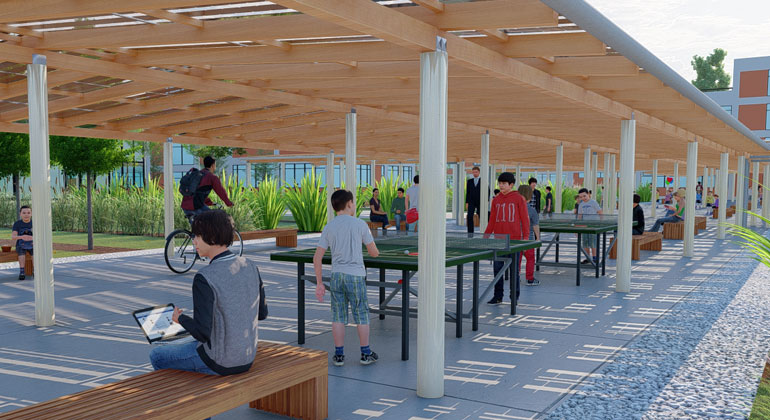UrbanPV: Case study of a schoolyard canopy with semi-transparent double glass modules
UrbanPV enables climate resilience and is self-financing through the energy generated.
The task
The playgrounds of an all-day school center in a small town in southern Germany were hardly used on hot days last summer because they did not offer sufficient protection from the strong solar radiation. A normal roofing would have resulted in a dark, unattractive “cave” that would also have had to be illuminated during the day. No funds were available for such a roofing.
The municipality contacted GridParity AG (GP) of Karlsfeld, near Munich, to investigate the possibility of partially financing the investment through electricity proceeds.
The concept developed by GP’s engineers is based on semi-transparent double-glass modules that let in a lot of light and create an attractive surface due to the interesting interplay of light and shadow.
The roof structures were to consist of glulam beams treated several times with wood preservative and placed on galvanized steel tubes. The electrical connections are safely routed in these tubes to the cable ducts in the ground. The concept is shown in Fig. 1.
The design is modular and, depending on the available investment funds, may initially consist of a few components that can then be expanded.
In the first phase, the offer provided four gable roofs with a PV connected load of 36 kWp and an annual electricity production of about 38,000 kWh. The investment costs were offered at a net € 60,000. The construction team of the municipality was ready to carry out the installation under expert guidance.
The remuneration offered by the municipal utility allowed a payback period of about 8 years without taking into account the expected subsidies under various support programs for urban development.
However, the immediate economic benefit is only a secondary aspect. The example impressively demonstrates the benefits of the system in providing shade and protection from precipitation (rain, snow, and hail). Reducing the overheating of large sealed areas in cities also plays an increasing role. In addition, there is the visual enhancement of the previously sterile schoolyard area, which in the future can also be used outside school hours, e.g. for games such as table tennis.
Climate change – worse than expected
The current evaluation of climate projections for the climate scenario RCP8.5 (DWD long-term forecast 2022) shows an increase in ground-level temperature of 3.1 °C to 4.7 °C for Germany in the period 2071-2100 compared to the reference period 1971-2000.
One can hardly imagine what this means for temperatures in urban centers.
Despite the increasingly clear forecasts, climate change has not yet made enough inroads into urban and landscape planning, even though it is clear that buildings planned today will shape our urban and landscape landscape for at least 30-40 years.
Integrated PV can make cities more climate resilient
By intelligently integrating UrbanPV into urban architecture, cities can become more resilient to climate change to create a livable environment.
Cost and revenue figures for the systems indicate that they are usually self-financing in a short period of time. Thus, they are not fanciful sketches of ideas whose realization is often not economically feasible. By integrating robust planting systems, the above goals of creating attractive urban spaces are achieved.









